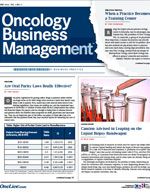Publication
Article
Oncology Business News®
Liquid Biopsy Mania Leaves Questions Unanswered
Author(s):
Many physicians are excited by the possibility of following the evolving story of their patients’ cancer no longer through images including PET scans, but through changes in the molecular phenotype of their patients’ tumors.
Andrew L. Pecora, MD
One must define the difference between the potential of a new test and its actual value. The first question that is usually asked: putting cost aside, how could more information hurt? It is, in fact, such an exciting time for medicine—particularly personalized/precision medicine in the era of genomics. Imagine not having to undergo the pain, risk, and expense of a tissue biopsy; instead, you just have a tube of blood taken. In addition to the more mundane search for circulating tumor cells—which has been used for decades in breast cancer to assess risk of recurrence—new technology allows for the detection of tumor-specific DNA using fast DNA sequencing machines.
Many physicians are excited by the possibility of following the evolving story of their patients’ cancer no longer through images including PET scans, but through changes in the molecular phenotype of their patients’ tumors. Questions raised are: what can the natural history of tumor evolution through blood biopsies tell me? Will it allow me to alter my therapy to prevent an outcome adverse to my patient? We just do not know for sure; and therein lies the problem.
When asked what harm blood biopsy information can do, let’s start with the clinical. It remains unclear what, if any, therapeutic action can change the natural history of a disease process that is already undergoing a specific therapy. There is no doubt that, in the prognostic sense, this information may be useful; however, we are nowhere near blood biopsies giving us actionable knowledge that would justify midstream changes in therapy. On the rare occasion when a new mutation shows up, then possibly a relevant targeted therapy change might be useful.
However, most times, a blood biopsy will show evidence of the same tumor-related DNA as before. If it were to increase in quantity or recur after abating and a patient is mid-cycle in therapy, what would a clinician and patient do? Stop therapy because it is futile, change therapy in a nondirected fashion, or ignore the test result altogether? In the context of clinical trials, to learn what should be done, promise remains. In the clinic, it is less clear.
Now let us discuss cost. This is not inconsequential.
We are facing a cost-of-care crisis in America. If we are going to add expensive tests—particularly if they are used frequently during the care of a patient—we must address how we are to pay for them. We are soon going to enter the zero-sum game in healthcare. Do we spend our resources on being able to predict relapse sooner or on new medications that hold promise? Doctors and patients will face these tough choices unless, together with clinical validation of blood biopsies, we also validate the economic value of the test to the patient and the payer.
Clonal evolution of malignancy, detection of minimal residual disease, and earlier detection of recurrence will all become routine with blood biopsy. To avoid becoming too enthusiastic about liquid biopsies, we need to focus on asking proper value-based questions to justify the excitement.










